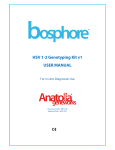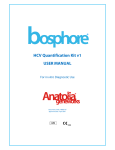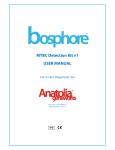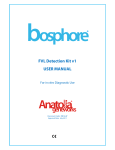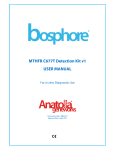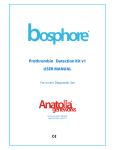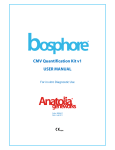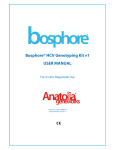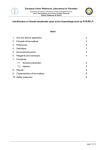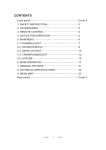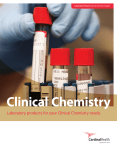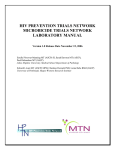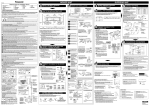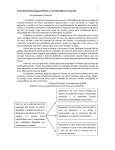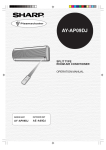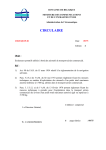Download HBV Quantification Kit v1 USER MANUAL ®
Transcript
® HBV Quantification Kit v1 USER MANUAL For in vitro Diagnostic Use ® Document Code: MB01v4f Approval Date: April 2011 IVD 1434 Contents Page 1. Product Description 1 2. Content 1 3. Storage 1 4. Required Materials and Devices 1 5. Important Notes and Safety Instructions 2 6. Product Use Limitations 3 7. Pathogen 3 8. Method 3 9. Procedure 4 9.1. Sample Preparation, Storage and Transport 4 9.2. Interfering Substances 4 9.3. DNA Isolation 5 9.4. Kit Components 5 9.4.1. PCR Mix 5 9.4.2. Detection Mix 1 5 9.4.3. Detection Mix 2 5 9.4.4. Internal Control 5 9.4.5. Positive Control 6 9.4.6. Quantitation Standards 6 9.5. Preparing the PCR 6 9.6. Programming the Montania® 483 Real-Time PCR Instrument 7 10. Analysis 9 11. Troubleshooting 11 12. Specifications 11 ii 12.1.Sensitivity 12.1.1. Genotype Detection 11 12 12.2.Linear Range 12 12.3.Cross-Reactivity 13 12.4.Reproducibility and Precision 13 12.5.Diagnostic Evaluation 14 12.6.Calibration Against WHO Standard 14 13. References 14 14. Symbols 14 15. Contact Information 15 iii 1. PRODUCT DESCRIPTION Bosphore® HBV Quantification Kit v1 detects and quantitates Hepatitis B Virus DNA in human serum or plasma, encompassing all the major HBV genotypes (A-H). The linear range of quantitation is 1x101-1x109 IU/ml and the analytic sensitivity is 10 IU/ml. A region within the S gene is amplified and fluorescence detection is accomplished using the FAM filter. An internal control has been integrated into the kit in order to check PCR inhibition. The amplification data of the internal control is detected with the Cy5 filter. The internal control can be added either during DNA extraction or PCR step. 2. CONTENT Bosphore® HBV Quantification Kit v1 is composed of Real-Time PCR reagents and quantitation serum standards which have been calibrated against WHO International Standard (NIBSC Code 97/750): Component REAGENT 1 2 3 4 5 6 7 8 9 10 dH2O PCR Mix Detection Mix1 Detection Mix2 Internal Control Positive Control 1 Standard 1 (1 x 106) IU/ml Standard 2 (1 x 105) IU/ml Standard 3 (1 x 104) IU/ml Standard 4 (5 x 102) IU/ml 100 Tests (1000 µl) (1400 µl) (79 µl) (95 µl) (560 µl) (45 µl) (880 µl) (880 µl) (880 µl) (880 µl) 50 Tests (1000 µl) (700 µl) (39.5 µl) (47.5 µl) (280 µl) (23 µl) (440 µl) (440 µl) (440 µl) (440 µl) 25 Tests (500 µl) (350 µl) (19.5 µl) (23.75µl) (140 µl) (11 µl) (440 µl) (440 µl) (440 µl) (440 µl) 3. STORAGE Bosphore® HBV Quantification Kit v1 PCR reagents should be stored at -20°C. Repeated thawing and freezing (>3x) should be avoided since it may reduce sensitivity. If the components are to be used in small amounts, they should be frozen in aliquots. While preparing the PCR; the components should not be exposed to room temperature for more than 10 min. and the detection mix components should not be exposed to light more than 1-2 min. We recommend preparing the PCR on a cooling block and keeping the detection mixes within a closed container. The components maintain their stability until the expiry dates on the labels, if they are stored at advised conditions. 4. REQUIRED MATERIALS AND DEVICES • Montania® 483 Real-Time PCR Instrument (Anatolia Geneworks), or another Real-Time PCR system with FAM and Cy5 filters (iCycler, iQ5, CFX–BioRad, LightCycler 1.5, 2.0, 480-Roche, 7500 Document Code: MB01v4f Date: April 2011 1 Real-Time PCR System-ABI, Stratagene Mx3005P, Mx3000P-Agilent, LineGeneK, LineGene 9600-Bioer, Rotorgene 2000, 3000, 6000, Q-Qiagen) • 0.2 ml Thin-Wall PCR tubes or strips • Magnesia® 16 Nucleic Acid Extraction System / Magnesia® Viral Nucleic Acid Extraction Kit (Anatolia Geneworks), or other high quality viral DNA extraction kits and systems • Deep freezer (-20°C) • Desktop centrifuge with rotor for 2 ml. microcentrifuge tubes • Calibrated adjustable micropipettes • DNAse, RNAse, pyrogen free micropipette tips with filters • DNAse, RNAse, pyrogen free 1.5 or 2 ml. microcentrifuge tubes • Disposable laboratory gloves 5. IMPORTANT NOTES AND SAFETY INSTRUCTIONS Important!: • The product should be delivered on dry ice. Check for presence of dry ice upon arrival. • Check for the expiry dates on the box and tube labels, upon arrival. Do not use expired products or components. • Calibrated or verified micropipettes, DNAse, RNAse, pyrogen free micropipette tips with filters, and DNAse, RNAse, pyrogen free microcentrifuge tubes should be used. • Before starting a test procedure, all components should be thoroughly thawed. After thawing, all components should be centrifuged briefly (spin-down for 3-5 seconds), and mixed well to ensure homogeneity prior to use. • The kit components should be kept on ice or a cooling block until the reaction is prepared, and they should be quickly returned to -20ºC. • PCR and nucleic acid isolation must be performed in different compartments. Samples should be stored separately to avoid contact with the kit components. • Pathogen information should be reviewed to be aware of the health related risks. • Serum samples (including the standards) should be handled with extreme caution, suitable class microbiological safety cabinet should be used: Physical contact with pathogens should be avoided by; wearing lab coats and gloves, no allowance for eating or drinking within the workspace, prevention of unauthorized individuals’ access to the working area. • All the pathogenic wastes produced during the nucleic acid isolation step; including the serum samples and material contacted with them, should be discarded into medical waste and disposed safely. Document Code: MB01v4f Date: April 2011 2 6. PRODUCT USE LIMITATIONS • All the components may exclusively be used for in vitro diagnostics. • This product should be used in accordance with this user manual. • This product is to be used by personnel specially trained to perform in vitro diagnostic procedures. 7. PATHOGEN Causative Agents Hepatitis B virus (HBV) is one of the smallest enveloped double-stranded DNA viruses, and a member of the Hepadnaviridae family. The replication process of HBV that takes place in liver, is unique among the animal DNA viruses in which reverse transcription is involved. HBV may destroy the liver and cause diseases such as cirrhosis and hepatocellular carcinoma. There are 8 distinctly classified genotypes of hepatitis B virus and further recognized subgenotypes. [1], [2] Epidemiology Hepatitis B virus (HBV) infection is a worldwide health problem with the highest burden of disease in Asia, Pacific Islands and Sub-Saharan Africa. There are 2 billion people infected worldwide (one third of world’s population), and 400 million suffering from chronic HBV infection (90% of infants and up to 50% of young children infected with hepatitis B will develop chronic infections). HBV infections result in roughly 1 million deaths per year; including the deaths caused by HBV and its complications (HBV-related liver diseases). [3], [4] Modes of Transmission: Transmission of hepatitis B virus follows the same modes as HIV, but unlike HIV, HBV is 50-100 times more infectious and survives in the open air for at least 7 days. Common modes of transmission are; perinatal (from mothers to infants primarily at birth), early childhood infections (inapparent infection through close contact with infected household), unsafe injection practices, blood transfusions and sexual contact. [4] 8. METHOD Bosphore® HBV Quantification Kit v1 is based on the Real-Time PCR method. Polymerase chain reaction is a technique that is used for amplification of a DNA region. The reaction occurs by the repeating cycles of heating and cooling. The main components of PCR are primers, dNTPs, Taq polymerase enzyme, buffer solution and template. As a brief explanation, primers are small synthetic DNA those anneal to the specific regions of the template in order to start the synthesis. dNTPs are the building blocks of the amplified products. Taq polymerase amplifies the DNA template. Buffer solution provides the pH adjustment required for the reaction and template, as referred, is the target region for synthesis. In Real Time PCR technique, in contrast to conventional PCR, PCR product can be monitored during the reaction. Therefore Real-Time PCR obviates the need for further analysis methods like gel electrophoresis, Document Code: MB01v4f Date: April 2011 3 whereby minimizing the risk of contamination. Dual labeled probes employed in the reaction in addition to the conventional PCR reagents, enable detection of the amplified target with increased sensitivity. The assay utilizes the 5’ exonuclease activity of Taq Polymerase to cleave a dual-labeled fluorescent probe during the extension phase of PCR. The probe is labeled at the 5’ end with a fluorescent ‘reporter’ molecule, and at the 3’end with another fluorescent molecule that acts as a ‘quencher’ for the ‘reporter’. When the two fluorophores are in close proximity, and the reporter is excited by light, no reporter fluorescence can be detected. During the elongation step of PCR, Taq Polymerase encounters and cleaves the probe bound to the template. As the reporter is freed from the suppressing effect of the quencher, fluorescence signal can be detected. The fluorescence generated by the reporter increases as the PCR product is accumulated; the point at which the signal rises above background level and becomes distinguishable, is called the threshold cycle (CT). There is a linear relationship between the log of the starting amount of a template and its threshold cycle, thus starting amount of unknown templates can be determined using standard curves constructed using CT values of the known starting amounts of target templates. Bosphore HBV Quantification Kit v1 employs multiplex PCR, and an internal control is incorporated into the system in order to control the isolation procedure and to check for possible PCR inhibition. HBV DNA and an internal control are co-amplified in a single reaction, using sequence-specific primers. The fluorescent signal generated by the HBV amplification is detected by a probe labeled at the 3’ end with FAM, through the FAM channel. The fluorescent signal generated by the internal control amplification, is detected by a second probe (labeled at the 5’ end with a different reporter molecule, Cy5) through the Cy5 channel. 9. PROCEDURE 9.1. Sample Preparation, Storage and Transport To isolate serum from the clinical specimen, the blood sample should be collected into sterile vacutainers without any anticoagulant. For venipuncture, only sterile material should be used. The serum should be separated from blood within 6 hours after blood collection. To separate the serum, the blood container should be centrifuged at 800-1600 x g for 20 minutes. The separated serum should be transferred to polypropylene tubes and stored at -20ºC or lower, until use. The samples should be transported in containers with capacity to resist pressure. Transportation should be done according to local and national regulations for pathogen material transport. 9.2. Interfering Substances The following factors may have possible influences on PCR: • Hemolytic samples, • Samples of heparinised patients, • Samples of patients with elevated levels of bile salts, bilirubin or lipids Document Code: MB01v4f Date: April 2011 4 9.3. DNA Isolation We recommend that the Magnesia® 16 Nucleic Acid Extraction System / Magnesia® Viral Nucleic Acid Extraction Kit (Anatolia Geneworks) isolation system is used with Bosphore® HBV Quantification Kit v1. The DNA isolation should be performed according to the manufacturers’ instructions. The starting volume is 400 µl, the elution volume is 60 µl and the amount of internal control that should be used during isolation for each system is 5 µl. The external quantitation standards are provided as serum, so that they undergo the same steps as the patient samples, starting from DNA isolation. 9.4. Kit Components 9.4.1. PCR Mix HotStarTaq DNA Polymerase: HotStarTaq DNA Polymerase is a modified form of a recombinant 94 kDa DNA polymerase, originally isolated from Thermus aquaticus, cloned into E.Coli. The enzyme is provided in an inactive form. It is activated by a 15-minute 95 ºC incubation step. This prevents the formation of misprimed products and primer-dimers during reaction setup and the first denaturation step, leading to high PCR specificity and accurate quantification. PCR Buffer: contains Tris-Cl, KCl, (NH4)2SO4, 8 mM MgCl2, pH 8.7 (20ºC ). dNTP Mix: Contains ultrapure quality dATP, dGTP, dCTP ve dTTP/dUTP. 9.4.2. Detection Mix 1 Detection Mix 1 contains HBV-specific forward and reverse primers and a dual-labeled probe. 9.4.3. Detection Mix 2 Detection Mix 2 contains internal control-specific forward and reverse primers and a dual-labeled probe. 9.4.4. Internal Control An internal control is included in the kit to control DNA isolation and PCR inhibition. The internal control is a synthetic DNA molecule derived from human genome. It is added into the serum, proteinase K and carrier RNA mixture during DNA isolation, to control the isolation efficiency and PCR inhibition. The amount of IC that should be added during isolation is 5 µl per serum sample. Alternatively, the internal control can be added directly into the PCR master mix to control the PCR inhibition exclusively. For this purpose, 0.1 µl of internal control should be added for each reaction into the master mix. Lack of internal control amplification in the FAM negative samples, may indicate a problem in isolation or PCR inhibition. In this case, isolation and PCR should be repeated. In samples that contain a high viral load, internal control can be suppressed and no increase of the signal is detected. Please use the table below for the interpretation of internal control data: HBV (FAM) + + - Document Code: MB01v4f Date: April 2011 Internal Control (Cy5) + + - Interpretation Sample positive Sample negative Sample positive Repeat the test! 5 9.4.5. Positive Control The positive control contains HBV DNA. It can be included in the PCR to test the efficiency of the PCR exclusively. The threshold cycle for the positive control is given in the acceptance criteria table (Section 10. Analysis). Threshold cycles higher than the acceptance criteria may indicate an efficiency loss in the reaction. 9.4.6. Quantitation Standards The quantitation serum standards are calibrated by WHO International Standard (NIBSC Code 97/750). 9.5. Preparing the PCR All four external quantitation standards should be added into the PCR reaction together with the samples and the negative control (PCR-grade water). Make sure that all the kit components are thawed before use. Refer to the table below for preparing the PCR. It is for only one reaction, multiply these values with the sample number to find the values required for the master mix. While preparing master mixes for more than 5 samples, an extra 10% should be added to the total sample number. When the Internal Control is added in the extraction step: PCR Mix Detection Mix 1 Detection Mix 2 dH2O Sample DNA (Standard, Negative/Positive Control) Total Volume 12.5 µl 0.7 µl 0.85 µl 0.95 µl 10.0 µl 25.0 µl When the Internal Control is added in the PCR step: PCR Mix Detection Mix 1 Detection Mix 2 Internal Control dH2O Sample DNA (Standard, Negative/Positive Control) Total Volume 12.5 µl 0.75 µl 0.85 µl 0.1 µl 0.85 µl 10.0 µl 25.0 µl Pipette 15 µl of the master mix into the PCR tubes or strips, and add 10 µl of DNA (sample/ standard/positive or negative control). Close the tube cap. Make sure that the solution in each tube is at the bottom of the tube. Centrifuge if necessary. 9.6. Programming the Montania® 483 Real-Time PCR Instrument The thermal protocol for Bosphore® HBV Quantification Kit v1 is composed of an initial denaturation for activation the HotStarTaq DNA Polymerase, a two-step amplification cycle and a terminal hold. The real-time data is collected at the second step of the amplification cycle. Initial denaturation Document Code: MB01v4f Date: April 2011 95°C 14:30 min. 6 Denaturation Annealing and Synthesis (Data Collection) Hold 97°C 54°C 00:30 min. 01:30 min. 22°C 05:00 min. 50 cycles Montania® 483 Real-Time PCR Instrument is installed and calibrated as it is delivered to the end user. In order to establish an appropriate link between the system components, first the thermal cycler and the optical module, and then the PC and the software should be started. Before starting a Real-Time PCR reaction using the Bosphore® Kits, the following steps should be completed: • Choose the filter pairs to be used (FAM and Cy5), • Identify unknown samples, standards, positive and negative controls, assign quantitative values to the standards, • Select the correct thermal protocol. These steps are described below: From the main menu of the Montania® 483 Real-Time PCR Instrument, “File” and then “New” is selected. “Create a new Experiment” is selected. In the “Select Channel” window channels 1 (FAM) and 3 (Cy5) are selected (Fig. 1). Standards, samples and negative controls are identified in the “Module Edit” menu (Fig. 2). Standards should only be defined for the FAM channel and their concentration/viral load should be entered. To select the thermal protocol “Gene Amplification” menu is used. The “Open” button in the “Experiment Program” is clicked and the appropriate thermal protocol is selected. (Fig. 3a). The thermal cycles of the selected protocol is displayed. The experiment starts by clicking the “Start” button (Fig. 3b). Fig. 1: Filter Selection in Montania® 483 Document Code: MB01v4f Date: April 2011 7 Fig. 2: Sample Location and Identification Fig. 3a: Selecting the Thermal Protocol Fig. 3b: Starting the Experiment Document Code: MB01v4f Date: April 2011 8 10. ANALYSIS By the end of the thermal protocol, the Montania® 483 Real-Time PCR Instrument software automatically calculates the baseline cycles and the threshold. Example of an amplification curve is given in Fig. 4. Fig. 4: Amplification Curve of a Bosphore® HBV v1 test The standard curve is plotted using the data obtained from the defined standards, with the axes CtThreshold Cycle and Log Starting Quantity. Example of a standard curve is given in Fig. 5 Fig.5: Standard Curve of a Bosphore® HBV v1 test Analysis of the results should be performed by trained personnel who have received the required training for analysing Real-Time PCR data. We recommend that the test results must be evaluated by an expert clinician, taking the patient’s clinical findings and the results of other tests into consideration. All analysis is done automatically in routine use. However, when the trained personnel, who have received the required training from manufacturer, consider it as necessary, the system allows pulling down the threshold as much as possible in order to detect low positive samples. In this case, attention should be paid to keep the threshold line above the background and to keep the correlation coefficient at the maximum possible value (and within its acceptance criteria. Document Code: MB01v4f Date: April 2011 9 The table below displays the acceptance criteria for Bosphore® HBV v.1. Component/Parameter Standard 1 Standard 2 Standard 3 Standard 4 Positive Control Correlation Coefficient PCR Efficiency* Cycle Threshold (CT) 23±2.5 27±2 30±2 35±2 33±4 >0.950 >%60 * PCR efficiency is calculated by the following formula: 10(-1/ slope)-1 x100 Test results should not be reported unless the assay results meet the criteria stated above. Please contact the manufacturer if an impairment in the product’s performance is observed (See the last page for contact information). The quantitative results of the test are displayed on the “Report Mode” screen. A spread sheet containing the calculated starting quantities of the unknown samples in each tube is shown. The samples that cross the threshold in Channel 1 (FAM) are displayed with a calculated starting quantity, samples that do not cut the threshold are displayed as “No Ct”. These samples are regarded as negative or having a viral load below the detection limit of the assay. For these undetectable samples, the Cy5 data of the internal control should also be checked to avoid false negative results (Fig. 6). Fig. 6: A Report Mode Screen Showing the Results The following table shows the possible results and their interpretation: Signal detected in FAM filter pair No signal in FAM, signal in Cy5 No signal in FAM and Cy5 The sample contains HBV DNA, the result is positive The HBV DNA in the sample is not detectable The diagnosis is inconclusive No need to check the internal control since the sample is positive (high positive samples may suppress the signal from the internal control) Signal from Cy5 filter pair rules out the possibility of PCR inhibition No signal in Cy5 points out to PCR inhibition or to a problem in DNA isolation (See 11.Troubleshooting) 11. TROUBLESHOOTING Please contact the manufacturer in case of a problem during a run. Late or no signal from the FAM filter Wrong thermal protocol is chosen Make sure that the correct thermal protocol is chosen. Late or weak signal from the standards Deterioration of the standards or Don’t use expired standards or kit components. Follow the the core kit components instructions for the storage of kit components (Section 3. Storage). Document Code: MB01v4f Date: April 2011 10 No signal from the internal control Deterioration of the internal control or detection mix 2 PCR inhibition DNA lost during isolation Follow the instructions for the storage of kit components (See Section 3. Storage). Make sure that you use the recommended DNA isolation method (See 9.3 DNA isolation). Make sure that you use the recommended DNA isolation method (See 9.3 DNA isolation). Signal from FAM Filter in the Negative Control Contamination Use filter-tips. Repeat PCR with new kit components. The Threshold is Above Low Signals The threshold should be manually Using the mouse pull the threshold down until it cuts the low adjusted signals. Avoid the background and the signal from negative control. 12. SPECIFICATIONS 12.1. Sensitivity Analytical sensitivity may be expressed as the limit of detection: i.e. the smallest amount of the target marker that can be precisely detected. The detection limit of an individual analytical procedure is the lowest amount of nucleic acid in a sample which can be detected but not necessarily quantitated as an exact value. The analytical sensitivity or detection limit for NAT assays is expressed by the 95% positive cutoff value. The analytical detection limit for Bosphore® HBV v1 was found to be 1x101 IU/ml (p=0.05). The sensitivity was determined using serial dilutions of DNA calibrated with the WHO International Standard for HBV DNA NAT assays, (NIBSC Code 97/750). The dilutions were tested in different runs in replicates. The results were analyzed by probit method. 12.1.1. Genotype Detection and Quantitation Efficiency Efficiency of detecting and quantitating different genotypes were ensured both by sequence comparison analysis and a Real-Time PCR assay using HBV DNA Genotype Performance PHD 350 (Seracare). The following genotypes were tested and found positive: Panel Member 1 2 3 4 5 6 7 8 9 10 11 12 13 14 15 Document Code: MB01v4f Date: April 2011 Genotype D D F C A E E E C F G H A B B HBV (FAM) + + + + + + + + + + + + + + + 11 12.2. Linear Range The linear range of Bosphore® HBV Quantification Kit v1 was determined to be 1x101-1x109 IU/ml. In order to assess the linear range, a dilution series of a member of HBV DNA Genotype Performance PHD 350 (Seracare) which has been calibrated against the WHO International Standard for HBV DNA NAT assays, (NIBSC Code 97/750) was analyzed by testing each dilution in 4 replicates (Fig. 7a and 7b). The standard curve correlation coefficient was found to be 0.99968. Fig. 7a: Linear Range Amplification Curve Fig. 7b: Linear Range Standard Curve 12.3. Cross-Reactivity To eliminate potential cross-reactivity, both assay design evidence and experimental studies were employed. Primer and probe sequences were checked for possible homology to other known pathogen sequences by sequence comparison analysis using database alignment. Samples of CMV, EBV, MTBC, Parvovirus B19, BKV with known high positivity were tested, and found negative. Document Code: MB01v4f Date: April 2011 12 12.4. Reproducibility Reproducibility data (on CT value basis) were obtained by the analysis of one of the quantitation standards of the Bosphore® HBV Quantification Kit v1. Test was performed in at least 4 replicates by 3 different operators, on multiple days, using 3 different lots. The resulting data is given in Table 1: Table 1: Reproducibility Data. HBV (104 IU/ml) Standard deviation Variance Coefficient of variation [%] Intra-assay Variability N=4 0.07 0.005 0.23 Inter-lot Variability N=3 0.10 0.01 0.34 Inter-operator Variability N=3 0.28 0.08 0.91 Total Inter-assay Variability N=5 0.29 0.08 0.93 HBV Quantitation Standards were calibrated against the WHO International Standard for HBV DNA NAT assays, (NIBSC Code 97/750) by performing two assays using various dilutions and testing them in triplicates. 1 IU was found to be equal to 4.5 ± 0,2 copies/ml . 12.5. Diagnostic Evaluation The diagnostic evaluation was performed by testing 100 HBV negative and 7 HBV positive serum samples which have been previously analyzed using Roche Diagnostics Elecsys 2010. All of the negative samples were found negative, and all of the positive samples were found positive with Bosphore® HBV Quantification Kit v1. 15 HBV positive serum samples which have been previously analyzed using HBV DNA Amplicor Monitor Test v2.0 Quantitative, COBAS HBV DNA Amplicor Monitor Quantitative and Diasorin ETIMAK2 HBsAg Plus Assay were tested with Bosphore® HBV Quantification Kit v1. All the samples were found to be positive, including the sample that could only be detected as positive by Diasorin ETI-MAK2 HBsAg Plus Assay, but was noted as below detection limit using HBV DNA Amplicor Monitor Test v2.0 Quantitative, and COBAS HBV DNA Amplicor Monitor Quantitative. 12.6. Calibration Against WHO Standard Quantitation Standards were calibrated against the WHO International Standard for HBV DNA NAT assays (NIBSC Code 97/750). 1 IU was found to be equal to 4.5 ± 0,2 copies/ml . Document Code: MB01v4f Date: April 2011 13 13. REFERENCES 1. K. E. Nelson, C. Williams, and N. Graham., Infectious Disease Epidemiology: Theory and Practice, July 15, 2000 , p :907-921 2. Barbara Rehermann and Michelina Nascimbeni, Immunology of Hepatitis B virus and Hepatitis C virus Infection , NATURE REVIEWS , Volume 5, March 2005, p: 215-229 3. Hepatitis B Fact Sheet No. 204. 2008, World Health Organization. 4. Jinlin Hou, Zhihua Liu, and Fan Gu, Epidemiology and Prevention of Hepatitis B Virus Infection, Int. J. Med. Sci. 2005 2(1),p: 50-57 14. SYMBOLS Use by Lot/Batch REF Catalog number Temperature limitation Caution, consult accompanying documents Manufacturer IVD In Vitro Diagnostic Medical Device 15. CONTACT INFORMATION ® Anatolia Tanı ve Biyoteknoloji A.Ş. Egitim Mh. Kasap Ismail Sk. No:10/23 Kadikoy 34722 ISTANBUL-TURKEY Phone: +90 216 330 04 55 Fax: +90 216 330 00 42 E-mail: [email protected] www.anatoliageneworks.com RegisteredTrademarks: Anatolia Geneworks® Montania®, Magnesia® and Bosphore® are registered trademarks of Anatolia Tani ve Biyoteknoloji A.S. Document Code: MB01v4f Date: April 2011 14

















